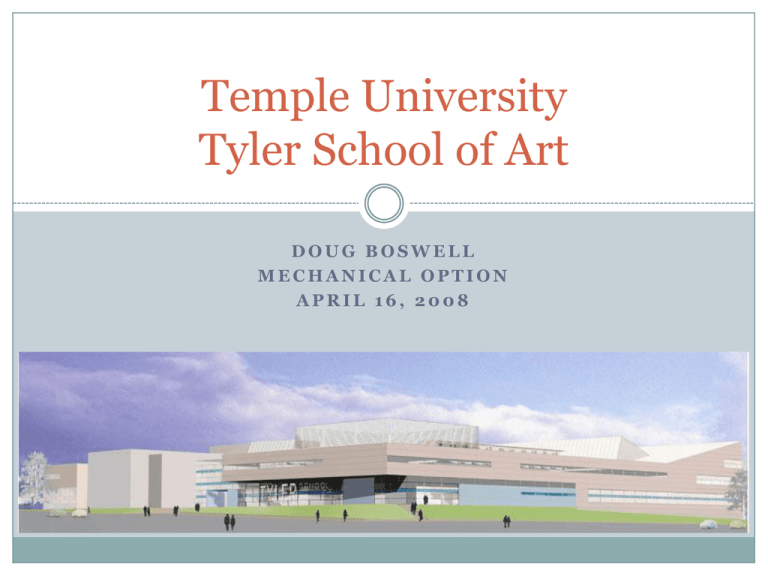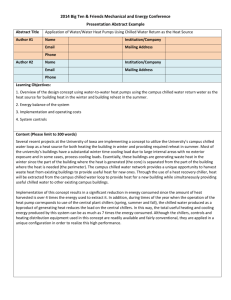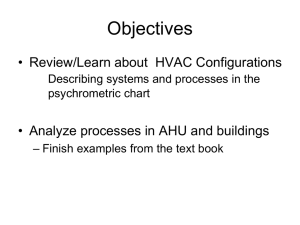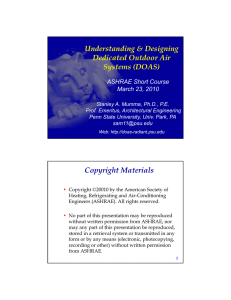Temple University Tyler School of Art
advertisement

Temple University Tyler School of Art DOUG BOSWELL MECHANICAL OPTION APRIL 16, 2008 Presentation Outline Project Overview Existing Mechanical Systems Proposed Redesign Annual Energy Cost and Consumption Electrical Considerations Mechanical Construction Cost Life Cycle Cost Analysis Conclusions Project Overview Building Owner: Temple University Building Location: Philadelphia, PA Campus moving from Elkins Park, PA to Main Campus Art Education Building divided by Departments 234,000 SF $75 Million Construction Complete January 2009 Tyler School of Art oDesigned by Carlos Jimenez oSchool Features 160,000 SF of Teaching Space oBuilding Includes Studio, Galleries, Administration, and Workshops oDepartments Include Painting, Metals, Printmaking, Sculpture, etc. o40% More SF than Elkins Park Campus View from Main Lobby Existing Mechanical Conditions Campus Chiller/Boiler Plant 40,000 lbs/hr of HPS supplied at 240°F HPS Converted to LPS LPS used for preheat coils, AHUs, and heat exchangers LPS Converted to Hot Water Heat through Heat Exchanger Hot Water System serves terminal heating equipment Hot Water Supply: 180°F Hot Water Return: 160°F Existing Mechanical Conditions Served by 3 RTUs & 4 basement AHUs 2 RTUs & 2 AHUs are VAV Reheat 1 RTU & 2 AHUs are CAV Reheat Units Range 35,000-62,000 CFM CAVR units are 100% OA Space Administration & Office Classroom Spaces Conference & Presentation Workshop & Studio Areas HVAC System Variable Air Volume Reheat (VAVR) Variable Air Volume Reheat (VAVR) Variable Air Volume Reheat (VAVR) Constant Air Volume Reheat (CAVR) Layout of Units VAV/CAV Advantages Low First Cost Low Maintenance Simple & Inexpensive Controls Flexibility VAV/CAV Disadvantages High Energy Consumption Inadequate Airflow Single Box Serves Multiple Spaces Large Ductwork Objectives Improve Energy Consumption Increase Energy Efficiency Reduce Outdoor Air Load Required Evaluate Long Term Economic Feasibility Redesign Summary Replace VAV/CAV units with Dedicated Outdoor Air (DOAS) Units Parallel Sensible System: Chilled Beams Dedicated Outdoor Air System (DOAS) Separates Latent from Sensible Loads Energy Savings with Decreased Fan and Chiller Energy Paired with Parallel Sensible System Indoor Air Quality Thermal Comfort Energy Recovery (Enthalpy Wheel) Included as Part of DOAS Advantages Of Enthalpy Wheel Reduce Cooling/Heating Loads Downsize Equipment/Ductwork Large Ventilation Disadvantages First Cost Fan Energy Required Air Filtration Enthalpy Wheel Chilled Beams Active Beams Mix Supply Air with Existing Air Active Chilled Beam Passive Beams Use Natural Convection Warm Air Rises While Cool Air Falls Passive Chilled Beam Chilled Beams Advantages Pump Energy instead of Fan Energy Mechanical System and Duct Reductions Higher Air Temperature Because Direct Cooling Disadvantages Cost Condensation High Sensible Loads U.S. Availability Lighting Coordination DOAS Ventilation Air Summary DOAS Ventilation Air Required DOAS Supply Air AHU-1/2 25,336 AHU-3/4 31,284 RTU-1 19,727 RTU-2 8,127 RTU-3 8,423 Total CFM 92,897 Square Feet Served 39,786 67,333 30,757 21,749 20,410 Supply Air Reduction Original Design Redesign Total CFM Total % Reduction 352,000 92,897 73 CFM/FT2 0.637 0.465 0.641 0.374 0.413 DOAS System Layout DOAS Units Required Total CFM Areas Served DOAS-1 22,213 RTU-2, RTU-3, AHU-3/4 DOAS-2 22,733 AHU-3/4 DOAS-3 25,336 AHU-1/2 DOAS-4 22,615 RTU-1, AHU-3/4 Chilled Beams Required Halton, Inc. Chilled Beams Used Heating/Cooling Wide Occupancy Ranges High Sensible Loads Chilled Beams Required Floor 1st 2nd 3rd Basement Total MBH 930.2 1344.4 418.8 310.3 3003.7 Chilled Beams Required 233 336 105 78 751 Halton CCE Active Chilled Beam Annual Existing Energy Cost Annual Operating Cost of $500,428.00 TYLER SCHOOL ORGINAL DESIGN Annual Revised Cost Total Cost (%) Air System Fans $135,442.00 27.1 Cooling $76,924.00 15.4 Heating $50,372.00 10.1 Pumps $26,110.00 5.2 Cooling Tower Fans $32,436.00 6.5 HVAC Sub-Total $321,285.00 64.2 Lights $107,486.00 21.5 Electric Equipment $71,657.00 14.3 Non-HVAC Total $179,143.00 35.8 TOTAL $500,428.00 100 CHIILLED BEAMS DOAS Annual Redesigned Energy Cost Air System Fans Cooling Heating Pumps Total Annual Cost Revised Cost (%) $42,329.00 24 $33,614.00 19.1 $69,548.00 39.5 $13,493.00 7.7 Cooling Tower Fans TOTAL $17,259.00 $176,243.00 9.8 100 Air System Fans Cooling Heating Pumps $19,591.00 $23,469.00 $18,153.00 $13,269.00 12.2 14.7 11.3 8.3 Cooling Tower Fans HVAC Sub-Total Lights $12,408.00 $86,889.00 $43,941.00 7.7 54.3 27.4 Electric Equipment Non-HVAC TOTAL $29,294.00 $73,235.00 $160.124.00 18.3 45.7 100 ANNUAL ENERGY COST Existing $500,428.00 Redesigned $336,367.00 Annual Energy Cost Savings of $164,061.00 Annual Energy Consumption $/yr ORIGINAL HVAC Electric (kWh) Natural Gas (Therm) Non HVAC Electric (kWh) TOTAL ELECTRIC 3,764,578 $271,240.00 38,006 $50,044.00 2,485,585 6,250,163 $179,144.00 $500,428.00 Annual Energy Consumption Electric (kWh) Natural Gas (Therm) $/yr 2,213,175 $161,739.00 47,034 $14,504.00 Electric (kWh) Natural Gas (Therm) Non HVAC 941,153 $68,854.00 13,270 $18,035.00 Electric (kWh) 997,188 $73,235.00 1,938,341 $142,089.00 HVAC CHILLED BEAMS Annual Energy Consumption Redesigned System DOAS Existing System TOTAL ELECTRIC TOTAL COST $336,367.00 Annual Energy Consumption Reduction of Approximately 33% kWh ANNUAL ENERGY CONSUMPTION Electric (kWh) Natural Gas (Therm) Existing System Redesign 6,250,163 38,006 4,151,516 60,304 Electrical Considerations WIRE SETS QTY./SET DESCRIPTI ON GROUND SIZE CONDUIT SIZE PER SET PER SET SERVICE EQUIPMENT REMOVED NO. FEEDER CONDUCTOR SIZE (AWG OR KCMIL) 225 225 250 250 225 225 225 100 225 100 3 3 3 3 3 3 3 3 3 3 200 200 250 250 200 125 200 100 125 100 1 1 1 1 1 1 1 1 1 1 3 3 3 3 4 4 3 3 3 3 3/0 3/0 250 250 3/0 1 3/0 1 1 1 6 6 4 4 6 6 6 8 6 8 2 2 2 1/2 2 1/2 2 1 1/2 2 1 1/2 1 1/2 1 1/2 AHU-1 AHU-2 AHU-3 AHU-4 RTU-1 RTU-1 RTU-2 RTU-2 RTU-3 RTU-3 EQUIPMENT ADDED PROTECTIVE DEVICE CB FRAME NO. TRIP POL (AM (AMPS) ES PS) 50 40 50 40 50 40 50 40 3 3 3 3 3 3 3 3 45 35 45 35 45 35 45 35 1 1 1 1 1 1 1 1 3 3 3 3 3 3 3 3 10 10 10 10 10 10 10 10 8 8 8 8 8 8 8 8 1/2 1/2 1/2 1/2 1/2 1/2 1/2 1/2 DOAS-1 DOAS-2 DOAS-2 DOAS-2 DOAS-3 DOAS-3 DOAS-4 DOAS-4 EXISTING SYSTEM COST CONDUCTOR $1,792.95 GROUND $339.73 CONDUIT $4,610.40 TOTAL COST $6,743.08 DOAS REDESIGN CONDUCTOR $228.16 GROUND $200.88 CONDUIT $1,076.32 TOTAL COST $1505.36 Potential Electrical Savings $5,237.72 Electrical Considerations Voltage Drop CONDUCTOR SIZE SERVICE DOAS-1 DOAS-1 DOAS-2 DOAS-2 DOAS-3 DOAS-3 DOAS-4 DOAS-4 (AWG OR KCMIL) 10 10 10 10 10 10 10 10 FT WIRE 52 52 56 56 40 40 100 100 Amp s 50 40 50 40 50 40 50 40 Voltage Drop VD % Less Than Per 1000 Amp-Ft 1.103 1.103 1.103 1.103 1.103 1.103 1.103 1.103 L to L 4.96 3.97 5.34 4.27 3.82 3.05 9.54 7.63 VD 1.03 0.83 1.11 0.89 0.80 0.64 1.99 1.59 3% Yes Yes Yes Yes Yes Yes Yes Yes NEC Suggests VD of 3% for Feeders or Branch Circuits Initial Cost Comparison CAV AHUs (2) VAV AHUs (2) CAV RTU VAV RTU (2) VAVR Boxes Diffusers Duct DOAS (4) Chilled Beams Electrical Totals Initial Total Cost Existing System DOAS Redesign $136,000.00 $42,100.00 $39,300.00 $98,800.00 $100,775.00 $65,856.00 $112,745.17 $67,782.18 $120,000.00 $1,502,000.00 $6,743.08 $1505.36 $602,319.25 $1,691287.54 First Cost Comparison $1,088,968.29 20 Year Life Cycle Cost Assume i = 0.06 Existing System DOAS Redesign $602,319.00 $1,691,287.54 Annual Operating Cost Annual Operating Cost $500,428.00 $336,367.00 Net Present Worth $5,739,869.74 3,858,095.85 Total Cost $6,342,188.74 $5,549,383.39 Initial Cost Years 20 Total Potential 20 Year Savings Payback = 8.7 years $792,805.35 Conclusion DOAS w/ Chilled Beams is Beneficial and Recommended for the Tyler School of Art Considerations DOAS Design Software Early Design Coordination for Chilled Beams Contractor Familiarity Acknowledgments I would like to thank the following for the help throughout the thesis process: AE Faculty AE Students Brinjac Engineering H2L2 Architects Questions?





